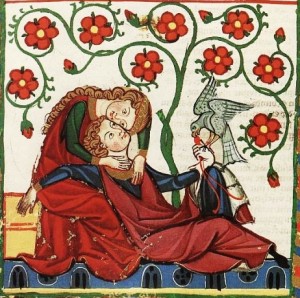
1093 AD
Leaked documents from the private correspondence of Anselm, Archbishop of Canterbury, are set to expose a love affair involving prominent members of the nobility.
Early in 1093, only months before his sudden death last year, Count Alan Rufus, the most powerful of the northern barons, travelled to Wilton Abbey, near Salisbury, to finalise his marriage to Mathilda, daughter of the king of Scotland in the face of outright opposition from the English King who has no desire to see his top man in the north in a close alliance with Scottish powers. At Wilton, he met 29 year old Gunhilda who, the documents suggest, instantly displaced Mathilda of Scotland as a marriage prospect. What makes the revelations so dramatic and controversial is that Gunhilda is the last surviving child of the former English King, Harold. As a young girl, in flight from the Normans after the death of her father at Hastings, Gunhilda took refuge at Wilton Abbey. There Count Alan met her and, according to the documents, fell in love. Although Gunhilda wore the habit of a nun, she had made no religious vows, which technically left her available for marriage. Her encounter with Count Alan reveals an extraordinary whirlwind romance, followed by a secret elopement from the Abbey but, whatever the intentions of the two parties, no marriage took place. Unwed, Gunhilda lived with Count Alan for a short time until his unexplained death on 4th August 1093. At his death, Gunhilda, far from returning to Wilton, continued to live with his brother, who had succeeded to his estates and title, in what relation of intimacy the documents do not reveal. Her reputation as a woman of talent and charm has been seriously damaged by these allegations of illicit cohabitation with successive lovers in a matter of months. Defiance and daring were always associated with her father, and she has shown herself, like him, willing to break rules and stake all on a risky gamble. The mystery deepens as to the motives of Count Alan and his brother. Why these important barons, in the face of ecclesiastical censure, and as an alternative to the important political alliance with the King of Scotland, should have preferred King Harold’s daughter, remains a matter of intense speculation. Were these brothers attempting to make an alliance with the former ruling house as the prelude to some projected coup? Later the same year, in a desperate bid to retrieve her reputation, Gunhilda wrote to Archbishop Anselm for advice. His letters in reply form the basis of the latest controversy over the leaked documents. According to our sources, Anselm wrote back in response to her confessions. “Receive, dearest and most longed-for daughter, receive these words to the honour of God and to your own great benefit as an admonition of your true lover.” Anselm goes on: “ You wrote me a letter full of sweetness….I hoped you would fulfil what you promised in God’s name…that you would not renounce the holy profession of which you then wore the habit.” Anselm’s views are clear. Her ‘true lover’ is Christ. Having worn the habit Gunhilda was bound to conventual life which could only be renounced under threat of damnation and so Anselm drives home the lesson of mortal frailty:“You loved Count Alan Rufus and he you. Where is he now? What has become of the lover whom you loved? Go now and lie with him in the bed where he now lies….” Archbishop Anselm’s two letters go on to counsel Gunhilda in urgent terms to return to religious life at Wilton. It is thought she may have done so but, according to an Abbey spokeman, her present whereabouts are unknown. The Archbishop was unavailable for interview but is understood to be disturbed by the lapse of security at his private office in Canterbury palace.
